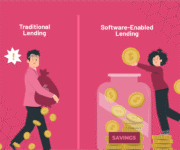Earned Wage Access (EWA) loans are reshaping the way short-term credit is delivered. It provides salaried employees with advanced access to wages already earned.
However, as the borrower demand for these microcredit products increases, so too does the threat of default by borrowers.
So, what’s the issue?
Traditional credit scoring models fail to measure the repayment ability of EWA borrowers, many of whom lack a substantial credit history.
Fintech lenders and NBFCs are, therefore, reconsidering how to measure risk for these loan products. In this article, let’s understand why traditional credit scoring does not work in EWA lending and examine some alternatives.
What Are EWA Loans and Why Are They Growing?
As noted above, EWA loan permit employees to access a share of their accrued but unpaid wages prior to the regular payday. So, they are not new loans per se, but are advances on already earned income.
In India, the EWA segment is rapidly gaining traction. A 2024 report predicts that the Asia-Pacific EWA market is set to grow from USD 0.25 billion in 2024 to USD 1.10 billion by 2033.
Earned Wage Access Loan: Reasons for Growth
The EWA market in India has expanded rapidly over the past two years. Key factors behind this growth include:
- Rapid Market Expansion: Over 40 EWA providers now operate nationwide. They integrate seamlessly with existing payroll systems, and they do not need extensive operational overhead.
- Employer Adoption Across Multiple Sectors: Organisations in IT, manufacturing, and retail have introduced EWA as a benefit to boost employee morale and retention. Many have noted tangible improvements in productivity and loyalty.
- Mobile Penetration and Tech-Enabled Platforms: Smartphone-friendly EWA apps allow employees to track and withdraw earned wages with ease.
- Gig and Contract Workforce Uptake: Gig workers and contractors often rely on on-demand wage access to manage variable incomes. This helps further expand the user base.
- Supportive Industry and Financial Wellness Trends: A growing focus on financial wellness, both from employers and policymakers, has created an environment in which EWA is viewed as a sustainable tool for workforce empowerment, reinforcing continued sector growth.
Despite these advantages, lenders are facing rising delinquencies in EWA loan portfolios.
Limitations of Traditional Credit Scoring in EWA
Traditional credit scoring systems, such as those used by credit bureaus, were designed for conventional lending scenarios—long-term loans, steady salaried borrowers, and extensive credit histories.
These models work well for mortgages or personal loans, where repayment behaviour is documented over time.
However, EWA loans operate in a completely different ecosystem. Here’s a closer look at why these systems fall short:
Lack of Bureau Visibility
Most EWA borrowers have little or no credit history, making them invisible to traditional scoring systems and hard to assess using bureau data alone.
Misalignment with Income Volatility
The irregular income patterns because of job changes, seasonal work, etc., are not reflected in credit scores, which results in risk underestimation in most instances.
Inability to Predict Short-Term Defaults
EWA loans are short-term in nature. Traditional scores do not capture a borrower’s immediate cash flow, which is critical to evaluate near-term repayment capacity.
Overdependence on Historical Debt Behaviour
Past loan performance doesn’t always reflect a borrower’s current financial discipline, especially for new-to-credit or recovered borrowers.
Outdated Data Refresh Cycles
Credit scores update with a lag. In the fast-moving EWA ecosystem, lenders need real-time data to assess repayment risk accurately.
Some Alternative Approaches to Assessing EWA Loan Risk
To manage EWA risk better, lenders must evolve beyond traditional credit scoring. Here’s what’s working for high-performing lenders:
1. Bank Statement Analytics
Analysing 6–12 months of bank transaction data provides real insight into income stability, cash flows, and spending patterns. Lenders should:
- Detect bounced mandates, penalty charges, and payday loan cycles.
- Assess salary credit frequency and consistency.
2. Employer Verification and Payroll Integration
Access to employer data adds another layer of context. Lenders can verify:
- Employment tenure
- Payroll cycles
- Employer stability
Some EWA platforms also integrate directly with HRMS or payroll systems, enabling direct deductions or reminders on payday.
3. Cash Flow-Based Scoring Models
Instead of static scores, modern lenders are now adopting behavioural and cash flow models. These scorecards evaluate:
- Day-to-day expense trends
- Variance between inflows and outflows
- Emergency fund indicators
Such dynamic models predict repayment ability more accurately than traditional scores.
4. Behavioural Data
Borrower behaviour during application (e.g., how fast they complete the form, tone of chatbot responses) can also be utilised to highlight risks.
5. AI-Powered Loan Management Systems
Post-disbursal engagement is key in EWA. Lenders who use AI-based Loan Management Systems (LMS) see better repayment adherence due to:
- Automated reminders
- Digital nudges based on behavioural triggers
- Early warning alerts on missed payroll
Such systems improve collections without human effort, reducing dependency on field agents.
Key Takeaway
Clearly, the EWA lending scenario requires a shift in risk assessment. Traditional credit scores alone cannot capture the nuances of income volatility, cash flow strain, or behavioural red flags common in this segment.
Using alternative data sources, behavioural analytics, and sophisticated modelling methods, lenders can better estimate risk and offer EWA services responsibly.
Finezza provides a wide range of tools that enable lenders to operate EWA loans successfully, from bank statement analysis to a loan management system and fraud detection models.
Book a demo today to explore how Finezza helps fintech lenders stay profitable in the evolving credit landscape.




Leave a Reply